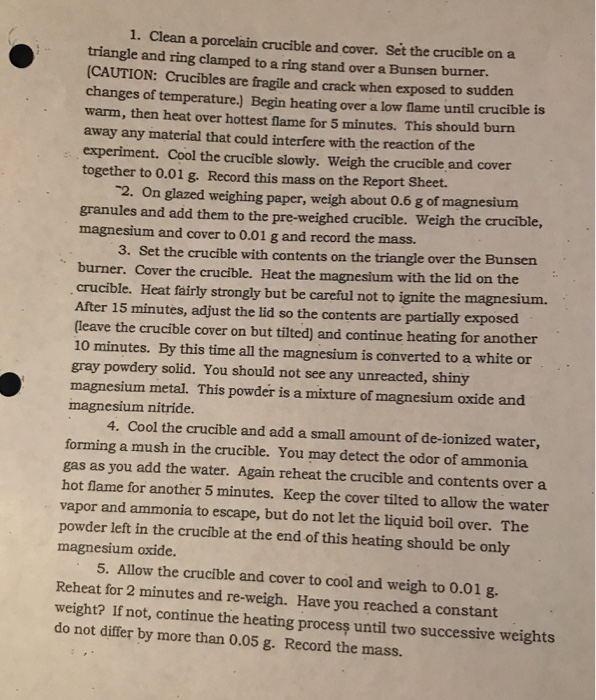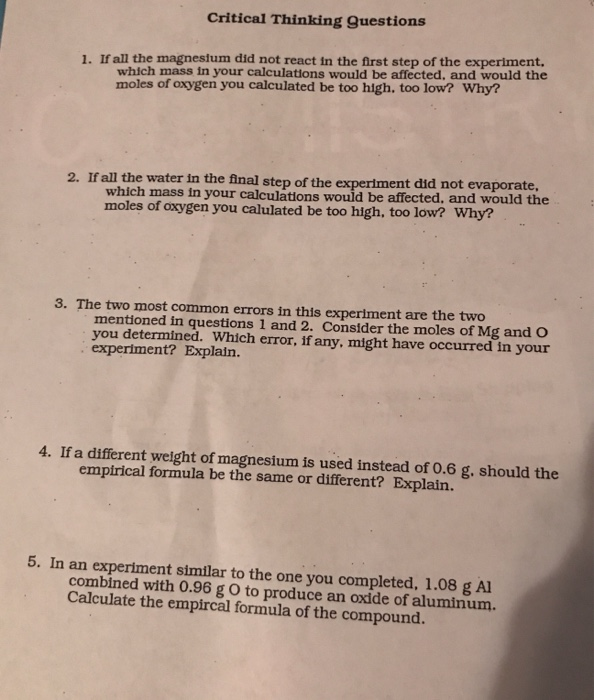Answered step by step
Verified Expert Solution
Question
1 Approved Answer
1. Clean a porcelain crucible and cover. Set the crucible on a triangle and ring clamped to a ring stand over a Bunsen burner.



1. Clean a porcelain crucible and cover. Set the crucible on a triangle and ring clamped to a ring stand over a Bunsen burner. (CAUTION: Crucibles are fragile and crack when exposed to sudden changes of temperature.) Begin heating over a low flame until crucible is warm, then heat over hottest flame for 5 minutes. This should burn away any material that could interfere with the reaction of the experiment. Cool the crucible slowly. Weigh the crucible and cover together to 0.01 g. Record this mass on the Report Sheet. 2. On glazed weighing paper, weigh about 0.6 g of magnesium granules and add them to the pre-weighed crucible. Weigh the crucible, magnesium and cover to 0.01 and record the mass. 3. Set the crucible with contents on the triangle over the Bunsen burner. Cover the crucible. Heat the magnesium with the lid on the crucible. Heat fairly strongly but be careful not to ignite the magnesium. After 15 minutes, adjust the lid so the contents are partially exposed (leave the crucible cover on but tilted) and continue heating for another 10 minutes. By this time all the magnesium is converted to a white or gray powdery solid. You should not see any unreacted, shiny magnesium metal. This powder is a mixture of magnesium oxide and magnesium nitride. 4. Cool the crucible and add a small amount of de-ionized water, forming a mush in the crucible. You may detect the odor of ammonia gas as you add the water. Again reheat the crucible and contents over a hot flame for another 5 minutes. Keep the cover tilted to allow the water vapor and ammonia to escape, but do not let the liquid boil over. The powder left in the crucible at the end of this heating should be only magnesium oxide. 5. Allow the crucible and cover to cool and weigh to 0.01 g. Reheat for 2 minutes and re-weigh. Have you reached a constant weight? If not, continue the heating process until two successive weights do not differ by more than 0.05 g. Record the mass. Data Table Report Sheet Empirical Formula of a Compound mass of crucible and cover mass of crucible, cover and magnesium mass of crucible, cover and magnesium oxide 37.44g 38.10g 38.59 Critical Thinking Questions 1. If all the magnesium did not react in the first step of the experiment, which mass in your calculations would be affected, and would the moles of oxygen you calculated be too high, too low? Why? 2. If all the water in the final step of the experiment did not evaporate, which mass in your calculations would be affected, and would the moles of oxygen you calulated be too high, too low? Why? 3. The two most common errors in this experiment are the two mentioned in questions 1 and 2. Consider the moles of Mg and O you determined. Which error, if any, might have occurred in your experiment? Explain. 4. If a different weight of magnesium is used instead of 0.6 g. should the empirical formula be the same or different? Explain. 5. In an experiment similar to the one you completed, 1.08 g Al combined with 0.96 g O to produce an oxide of aluminum. Calculate the empircal formula of the compound.
Step by Step Solution
★★★★★
3.52 Rating (145 Votes )
There are 3 Steps involved in it
Step: 1
1 If all the magnesium did not react in the first step of the experiment the mass of the magnesium w...
Get Instant Access to Expert-Tailored Solutions
See step-by-step solutions with expert insights and AI powered tools for academic success
Step: 2

Step: 3

Ace Your Homework with AI
Get the answers you need in no time with our AI-driven, step-by-step assistance
Get Started


